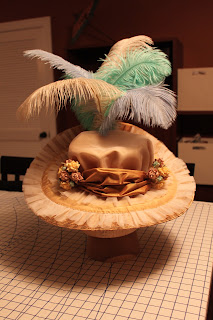With the Accessories Conference looming a short distance away, I keep reading blogs from ladies who are building quite a trousseau to bring with them! Unfortunately I don't have the time to build a new gown, nor do I really need to with the number of things I have. So, what better way to prepare for that conference than to build a bunch of accessories? The Robe a la Polonaise I recently finished seems to show just about anything you can imagine with it in its fashion plates, so that seems like the best outfit to revolve around. My new Brunswick jacket already has a fur muff and there's not much to do other than that. I don't know how many items I'll finish by March 12th, but I will certainly keep posting them here as I go along. First on the list is a GIANT fluffy hat.
I wanted something akin to these. I have plenty of taffeta, silk gauze, ostrich feathers, and even paper flowers.
Making an aqua and yellow hat seemed way too matchy-matchy, so I started with just the yellow silk from the trim. I decided to do a pouf in the middle, silk covered in gauze. The gauze strips will gather around the edge and the silk donut will cover their inside edge.
I first gathered and stitched down the ruffle. I'm trying to hold the back up with a few tacks so it can bend overnight.
Next I stitched down the silk donut. You can see how the backside is already prone to curve a bit. I used a spaced back-stitch, but kind of wish I had slip-stitched it instead, even if that would be more difficult. I also ironed the gauze down a bit.
Then gauzy pouf! I left the gauze 2" larger around than the silk for a second ruffle and gathered both pieces together.
I found another taffeta in my stash that was a slightly pinker yellow, bordering on rose. I took a 10" strip and ironed the edges over. I did quick pleats at the flowers and the back to gather it down.
The rest of the silk length I played around with for a bit, trying bows and fans, but finally settling on pulling it over the edge into the crown.
Next I played around with the flowers a bit more, tacking them down, and organized the feathers. I have so many colors of each that it really was a bit of a challenge as to what to use. In the first picture you can see the Polonaise it's meant to go with. In the second, I've curved the feathers a bit more so they don't stick up so high and tacked the brim to the crown in back so it stays curved up.
Quick mirror pictures. I need a bigger wig, mostly in width. Certainly seems like an appropriate Spring outfit though! I also need to tack the flowers and feathers more, especially in case of a windy day.
Today I'm working on recovering an antique parasol, if only I could get the MFA website to co-operate!!
I wanted something akin to these. I have plenty of taffeta, silk gauze, ostrich feathers, and even paper flowers.
Making an aqua and yellow hat seemed way too matchy-matchy, so I started with just the yellow silk from the trim. I decided to do a pouf in the middle, silk covered in gauze. The gauze strips will gather around the edge and the silk donut will cover their inside edge.
I first gathered and stitched down the ruffle. I'm trying to hold the back up with a few tacks so it can bend overnight.
Next I stitched down the silk donut. You can see how the backside is already prone to curve a bit. I used a spaced back-stitch, but kind of wish I had slip-stitched it instead, even if that would be more difficult. I also ironed the gauze down a bit.
Then gauzy pouf! I left the gauze 2" larger around than the silk for a second ruffle and gathered both pieces together.
I found another taffeta in my stash that was a slightly pinker yellow, bordering on rose. I took a 10" strip and ironed the edges over. I did quick pleats at the flowers and the back to gather it down.
The rest of the silk length I played around with for a bit, trying bows and fans, but finally settling on pulling it over the edge into the crown.
Next I played around with the flowers a bit more, tacking them down, and organized the feathers. I have so many colors of each that it really was a bit of a challenge as to what to use. In the first picture you can see the Polonaise it's meant to go with. In the second, I've curved the feathers a bit more so they don't stick up so high and tacked the brim to the crown in back so it stays curved up.
Quick mirror pictures. I need a bigger wig, mostly in width. Certainly seems like an appropriate Spring outfit though! I also need to tack the flowers and feathers more, especially in case of a windy day.
Today I'm working on recovering an antique parasol, if only I could get the MFA website to co-operate!!

















































